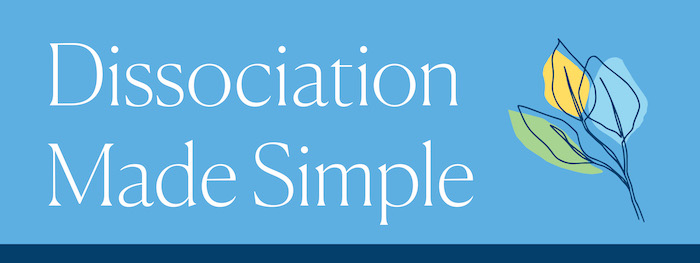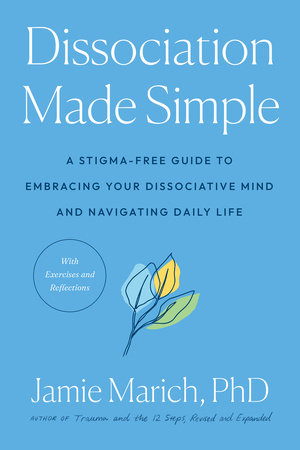
Dissociation Made Simple Excerpt
Categories: Excerpt Health & Healing Psychology & Personal Growth
 Dissociation is a normal part of the human experience, especially when we grow up chronically exposed to trauma and stress. Or when we are born into an environment where we feel misunderstood, marginalized, or otherwise chastised for living our fullest expression of ourselves. Yet dissociation remains one of the most misunderstood phenomena in both the mental health field and in society at large. We’ve gotten more savvy about understanding trauma, which can generally be defined as any unhealed human wound. These wounds can be emotional, physical, sexual, spiritual, somatic, financial, existential, or they can exist in any combination. The English word trauma comes from the Greek word traumatikōs meaning “wound.”
Dissociation is a normal part of the human experience, especially when we grow up chronically exposed to trauma and stress. Or when we are born into an environment where we feel misunderstood, marginalized, or otherwise chastised for living our fullest expression of ourselves. Yet dissociation remains one of the most misunderstood phenomena in both the mental health field and in society at large. We’ve gotten more savvy about understanding trauma, which can generally be defined as any unhealed human wound. These wounds can be emotional, physical, sexual, spiritual, somatic, financial, existential, or they can exist in any combination. The English word trauma comes from the Greek word traumatikōs meaning “wound.”
You may even have heard the phrase trauma-informed used to describe care within a system. To be truly trauma-informed, or equipped to deal with the wide array of human wounding, we must become dissociation-informed as well because trauma and dissociation go hand in hand. Trauma survivors rely on some degree of dissociation in order to cope with and navigate life. Citing the wisdom of Amy Wagner, a colleague who lives with a dissociative experience of life, “If trauma is walking through the door of your clinic, dissociation is parking the car.” You’ll learn more about Amy’s experience later in this book.
In larger society, the word dissociation is fortunately coming into wider use. Yet if the public knows anything about the clinical manifestations of dissociation, it’s most likely the old label of Multiple Personality Disorder. And media portrayal of Multiple Personality Disorder in the era of earlier Diagnostic and Statistical Manuals (DSM), and now the portrayal of what is presently called Dissociative Identity Disorder (DID), is typically sensationalized, inaccurate, or both. Only the most extreme cases tend to be highlighted in all forms of media—including the popularity of DID on social media platforms like TikTok—which heightens the stigma, promotes the spread of misinformation, and can ultimately make people afraid of dissociation. As many contributors to this book pointed out, even the more responsible portrayals of dissociative disorders in media are still highly problematic because they can focus on the most dramatic aspects of dissociative disorders, like switching between parts or alters on a regular basis. As Jaime Pollack, a woman living with DID and founder of the revolutionary organization An Infinite Mind pointed out in an interview with me, “I think most people would be surprised to see how boring and routine my life really is.”
Yes, you may be frightened when you realize that dissociation applies to you, just as so many clinicians out there can be fearful of addressing it with you. Yet the aim of this book is to share more stories like Jaime’s so that we can all be less afraid of how dissociation shows up in the human experience. Because at the end of the day, even though dissociation can cause its share of problems individually and at the societal level, our ability as humans to dissociate truly is a superpower—this recurring theme popped out more than any others in conducting interviews with sixty-one contributors for this book. Another major theme that emerged from interviewing contributors for this book project is that dissociation is not a dirty word. I know of several clinicians who hear the word dissociation, or see signs of it in their office, and automatically think it’s a problem. While dissociation, or specifically the traumatic roots of it, can cause problems in daily living or in societal systems—problems that need to be addressed—dissociation is the skill that has allowed so many of us to survive and, in many ways, to thrive.
I write this book primarily for the general public and people struggling with mental health who may have heard the word dissociation in reference to themselves. Maybe you saw the popular meme floating around at the beginning of the COVID-19 pandemic that touted: “Some of you lack the dissociative skills to survive the apocalypse, and it shows,” and inside said to yourself…um, that’s me! Perhaps you’ve even received a formal diagnosis or are working with a therapist on another mental health issue and they mentioned that dissociation or parts may be a factor in your case.
You may be the loved one of someone with a dissociative disorder or someone navigating complex trauma recovery, and reading this book is an effort to better support the person you care about. If you are a therapist reading this book, you likely picked it up to better understand what’s going on with your clients. You may even be a teacher, a coach, or another professional who is reading this book with a similar intention of learning how to better help the people you serve. Yet I challenge you to consider that to truly do that, you must first do some deep digging on how dissociation manifests in your own life. Engaging in this personal work is definitely not easy, yet it’s one of the surest ways to “make simple” (or at least, simpler) the process of understanding dissociation, embracing it, and navigating its manifestations in daily life.
Whatever led you to pick up a copy of this book, I recognize that exploring your own relationship with dissociation can feel frightening. I also know from personal experience that not engaging in this exploration and healing can be an even greater risk. At the very least, you may remain further dissociated from the life you deserve to be living.




